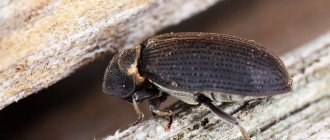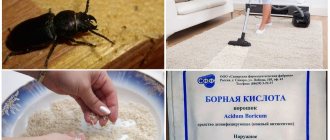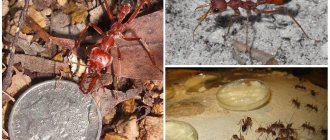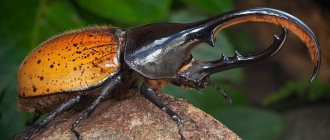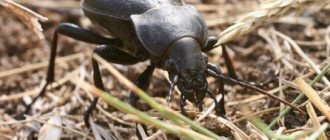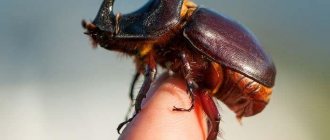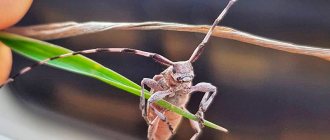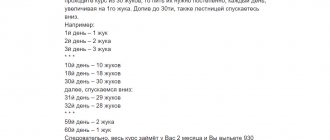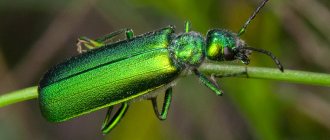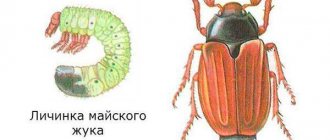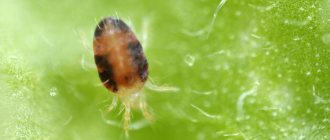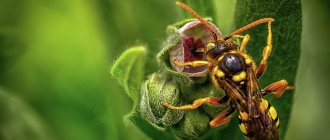Strigun beetle: photo
Handsome beetle.
Types of longhorned beetles
There are many longhorned beetles, depending on certain characteristics they are combined into groups. Thus, woodcutter beetles that specialize in the destruction of spruce, pine and fir trees include the short-whiskered beetle, the shiny-breasted beetle, the ribbed beetle and the rustic beetle. The second group: large and small ragii, black spruce longhorned beetle, and bronze pine pest. They gnaw the needles, thereby damaging the health of the tree, and then settle into its wood. It is the active activity of pest beetles of the second group that is the most common cause of the extinction of entire areas of forested areas. The third group of longhorned beetles are squeaky beetles. They prefer deciduous trees, including birch, aspen, and willow. These include the greater and lesser squeakers, marbled squeakers, musky barbels, spiny barbels, as well as certain species of sandpipers.
Who is the snow beetle?
Name: Strigun beetle or handsome beetle Lat.:
LethrusClass: Insects - Insecta Order: Coleoptera - Coleoptera Family: Dung beetles - Geotrupidae
| Habitats: | Palearctic, fields and steppes |
| Dangerous for: | greenery of various plants |
| Means of destruction: | special drugs, traditional methods |
The snow beetle is a member of the dung beetle family and is also often called the dung beetle, snow beetle, or capitol beetle.
Handsome beetle.
The body length of the swifts is on average 1.5-2.5 cm, and only in rare cases can it reach 3.5 cm. The body, head, legs and jaws of the insect are large and massive. Thanks to this body structure, the beetle easily digs deep holes.
Males have special appendages on their jaws that are shaped like fangs. The insect's paws are covered with many hard hairs, and there are claws at the ends. The flying wings of striguns are reduced, and the elytra are not divided and are more like a hard shell.
The color of the body and limbs of the snow beetle is black, most often matte. Sometimes the color may have a glossy blue tint.
Where does the snow beetle live?
The habitat of representatives of this species is located within the Palearctic. The largest number of snow beetles is concentrated in Central Asia. The conditional extreme points of the range of these beetles are considered to be the Balkan Peninsula in the west, the Orenburg region in the north, Mongolia in the east, Iran and Afghanistan in the south.
A little bit of biology
Longhorned beetles have fairly small sizes (from one to several tens of millimeters), a flat body and mustaches, which are the main organ of smell. The color of lumberjacks is usually brown or dirty gray; less commonly, the longhorn beetle is black. The photo allows you to examine the insect in more detail.
The larvae of the pest are characterized by particularly powerful jaws, thanks to which they can handle both hard wood and soft metal with a cable-type coating. However, the beetles do not eat the latter so readily, preferring wooden structures and stacked boards.
The female barbel lays her eggs (from 200 to 400 pieces) in recesses or cracks in the tree, and after 7-14 days the larvae are born, which instantly activate the process of destroying the tree.
It is worth emphasizing that it is almost impossible to immediately notice a tree disease, since the larvae lead a hidden lifestyle. So, you can understand that your wooden house has succumbed to the harmful effects of longhorned beetles only when the real results of their work (destroyed and loosening wood) are visible.
Lifestyle of the snow beetle
Handsome beetle: aggressive predator.
Swifts live in deep burrows that they dig themselves. The depth of such an underground dwelling can reach 50 cm. Inside the burrow, insects create several branches with small “rooms” at the ends, in which they prepare food for future offspring.
Throughout their lives, adult individuals fill prepared rooms with pieces of green shoots and leaves. Bacteria and fungi process the accumulated greenery and turn it into silage, which the newborn larvae subsequently feed on.
Habitat and lifestyle
Black beetles with mustaches, Striguns, in Russia live mainly in warm southern regions, in the steppe. Crawlers live where there is an opportunity to lay eggs. For masonry are used:
- grapevines;
- thickets of bushes;
- fallen, cut down trees;
- root system of trees;
- arable land;
- uncultivated, abandoned areas;
- clearings, clearings;
- forest areas damaged by fire;
- soft soil of personal plots and vegetable gardens.
For information! For their ability to dig holes in hard, unplowed soil, the beetles received another name - virgin soil.
Striguns are insects with complete metamorphosis; they go through 4 stages of development in life:
- Females lay eggs in prepared chambers in the ground.
- Under favorable conditions, larvae hatch from the eggs after 3 weeks. In the larval stage they feed on hay prepared by the “parents”. The body of the larvae is soft, light-colored, covered with skin, and completely unlike the adult. The head is small, dark, enclosed in a hard chitinous capsule.
- The pupal stage lasts 2-3 weeks.
- Young insects can overwinter again in their cell. Adults emerge from their burrows from March to July, mate, and the breeding cycle repeats.
For information! Fungi that ferment grass in burrows promote digestion, rapid growth and development of larvae.
What harm does the snow beetle cause?
In the process of stockpiling food supplies, beetles of this species eat almost everything. They destroy:
- young shoots;
- leaves;
- inflorescences;
- kidneys
If no measures are taken to combat the beetles, then only 10 adult individuals can cause serious damage to all plants within 5-7 square meters. Most often, the following crops become victims of striguns :
- sunflower;
- corn;
- garden strawberries;
- grape;
- strawberry;
- decorative flowers.
Lifestyle, nutrition
Zhuk kravchik in Ukrainian means tailor. The insect cuts off plants with its powerful jaws, just as a barber cuts hair.
It cuts off leaves, cuttings, shoots, inflorescences, flowers, even young grapevines along the way. Unlike its relatives, the dung beetle, the snow beetle feeds not on animal excrement, but on grass.
It cuts everything in its path - seedlings, garden crops, shrubs, vineyards, ornamental flowers. In one day, the pest is capable of destroying 10 grapevine shoots.
Interesting! The Strigun insect drags the greenery into a hole and compacts it tightly. Under the influence of bacteria, the reserves begin to rot and turn into silage. This is the main food of adult beetles and their larvae.
How to get rid of snow beetles
This type of beetle is quite difficult to drive away from the site. They reproduce very actively, and deep burrows help them hide and wait out treatment with many means.
Special preparations
Treatment with chemicals does not always bring the desired effect in the fight against snow beetles.
Do you use chemicals?
Not really
In order for the drug to have an effect on the pest, it is necessary to carefully treat the entrances to the burrows and the soil around them, as well as the green parts of plants growing nearby.
The best insecticides against snowflakes are:
- Decis;
- Arrivo;
- Diazinon.
Traditional methods
There are not many folk recipes that give results in the fight against harmful beetles. The most effective of them are:
Boiling water or soap solution
One of the selected products is used to fill the insect hole. The procedure should be performed at a time of day when the beetle is likely to be inside - before dawn or after sunset.
Polyurethane foam
This method is indeed very effective in controlling insects, but the problem is that the substances contained in the foam are toxic and can be absorbed into the soil, making it unsuitable for growing crops.
Vegetable oil
A solution of 2 liters of water and 100 ml of oil is poured into the holes. Once the oil enters the respiratory organs of insects, it simply blocks their access to oxygen. As a result, the insects crawl out of their home and die from suffocation.
Digging the soil
Digging up the soil to a depth of 30 cm at least several times a year will regularly destroy the pest’s home and destroy most of the future offspring. It is especially important to carry out the procedure in spring and autumn.
Features
The woodcutter beetle has a number of characteristic features that distinguish this type of pest from many others. These include:
- Long mustache. The longhorned beetle has prominent whiskers that are 2-5 times longer than the insect itself.
- Slender and elongated body. The length of the body varies from 3 to 60 mm.
- Wings. Some species of woodcutter beetles can fly.
- Hair.
Hair beetle
Hair chewer.
People used to scare fashionistas with a beetle or a hair-cutter. Allegedly, if this creature gets tangled in hair, it will create a large bald spot, cutting off the hair with an unpleasant grinding sound. But another beetle is considered a hairbiter - the spruce or pine longhorned beetle .
It terrifies many people. Often, during the hottest season, the swift beetle sits on people's light-colored clothing or bare parts of the body to cool down and rest. They look intimidating, but apart from an unpleasant image, they do nothing bad to people. They feed on coniferous wood, but are not so common as to be a serious pest.
Why is it dangerous?
In the wild, the presence of the beetle is practically not felt. Lives in the ground, cuts grass, helps loosen the soil.
But the black beetle in the garden turns into a real agricultural pest.
The insect prefers hard ground, untouched lands, but often approaches human possessions in search of more “tasty” food.
Important! Absolutely all crops in the vegetable garden, flower beds, and gardens can suffer from the activity of beetles. With powerful jaws, pests calmly cut off young shoots, stems, leaves, and flowers.
A dozen adult individuals per season can destroy a young vineyard, a bed of wild strawberries, or strawberries.
Krawczyk is not dangerous to humans; he will never attack first. It may pinch the skin in defense if you pick it up.
Agrotechnical methods
The snow beetle is unusually tenacious, so the most important weapon against it is the timely implementation of such agrotechnical measures as:
- pre-winter and early spring mechanical tillage (digging, plowing, loosening);
- cleaning and disposal of fallen leaves, tops, old mulch;
- timely weeding of rows;
- mulching the soil under plants with sawdust, pine needles or crushed bark, straw;
- application of insecticides of contact-intestinal action (Volaton) during digging (ploughing) of the soil;
- treatment of edge strips of the site with chemicals;
- spraying wastelands adjacent to the treated area with an 80% aqueous suspension of chlorophos.
Another successful solution to the problem is the construction of trapping ditches: along the border of the site, a trench is dug with steep walls 20-25 cm wide and about 30 cm deep. Flightless crabs caught in the trap cannot get to the surface, and all you have to do is destroy them. As traps, you can use old buckets, halves of plastic bottles, pieces of pipes of a suitable size, dug into places where beetles accumulate.
Morphology
Larva
The larvae are soft, elongated, almost cylindrical, milky white in color. The mouthparts are usually dark to black in color and heavily sclerotized. The thorax, consisting of three segments, is usually wider than the abdomen, consisting of 9 segments.
The larvae of Prionoplus reticularis, New Zealand's largest endemic beetle, reach a length of 70 millimeters
Three pairs of legs located on the chest are barely visible or completely absent. On the upper and lower sides of the abdomen there are often thickenings, the so-called motor calluses, that help movement.
The barbel larva lives in wooden structures of buildings
Doll
Barbels have an open type of pupae - the rudiments of wings, limbs and antennae are free (not fused), but only pressed to the body. Pupation differs among different taxonomic groups. In most prionines, as well as some primitive lepturines from the tribe Ragiini (Carilia, pachyta, etc.), the last instar larva emerges from the wood into the soil, where it builds a pupal chamber and pupates. Similar behavior is also characteristic of Dorcadiinae (a subfamily of Lamiinae), but their larvae live in the soil, where they pupate. Most of the true longhorned beetles, lepturine, lamyin and spondylidin, pupate in wood - some gnaw into the thickness of the tree, where they build a pupal chamber from the shavings (for example, oak, black and house longhorned beetles), others pupate under the bark (for example, ragii longhorned beetles). Progressive tribes of lamiina - Agapanthiini, Phytoeciini, etc. - pupate in the stems and rhizomes of various herbs.
Pupa of two-striped ragiya
Imago
Adult beetles most often have an elongated body shape, 3–170 mm long. They come in either a single color or multi-colored with different patterns, usually blending in with their surroundings. However, there are also brightly colored species and those with a metallic tint. The surface of the prothorax and elytra can be smooth, dotted or wrinkled, and sometimes covered with hairs.
Great oak longhorned beetle
The head has long antennae, usually longer than the body, but in some (for example, in the genus of root beetles - Dorcadion) they are relatively short. Most often, the antennae in the base area grow from the eye, which takes on a kidney-shaped shape.
The head of the gray long-horned beetle is directed at an angle of 90° to the axis of the body - typical for the subfamily Lamiina
Name
The family name Cerambycidae is a Latin neologism that did not exist in classical Latin, but was created in the time of Carl Linnaeus. It is formed by the comparison of two words: the ancient Greek ceros - “horn” and the Latin bis - “two”, which means “two-horned”. This name reflects the characteristics of the antennae of longhorned beetles - the length and their forward direction during life, associated with horns. In many Western and Central European languages, the name barbel is associated specifically with horns: English. Longhorn beetle, fr. Longicornes, Spanish Escarabajos longicornios, German. Bockkafer, Polish. Kózkowate and the like. At the same time, two distinct names were established in southern and eastern European languages. The first associates antennas with mustaches: Russian. mustache, Ukrainian vusachi, white vusachis and the like. The second is with feeding on wood at the larval stage: Rus. woodcutters, white Dryvaseki, Bulgarian Seckovci, Czech. Tesaříkovití, etc.
Musk barbel
In the Ukrainian language, in addition to the generally accepted and basic name “usachi”, the following are also known: skripuni, skripunuvati, dovgorozhtsi, kovzani and cossacks. The names “skripuni” and “skripunuvati” are associated with behavioral features - suddenly seized imago barbels make a creaking sound, rubbing the pronotum against the mesonotum; the name “Dovgorozhtsi” indicates the similarity of the antennae with horns; “Kovzani” (Russian “skates”) - for the similarity of the antennas with the skates (runners) of a sled; “Cossacks” - for the similarity of the antennae with the long mustaches of the Cossacks.
The best chemicals
Insecticides are used to control insect pests. The best time to treat the soil with them is during the flowering period of apple trees. For the most part, chemicals are not able to completely destroy snowbirds. They hide in their burrows and wait out the processing time. To achieve a positive effect, the soil is treated during insect breeding.
Along with soil cultivation, plant foliage can be sprayed with chemical solutions. Insects escaping from the effects of the drugs are collected by hand and burned. When preparing solutions, it is important to strictly follow the dosage recommended by the manufacturers.
"Decis"
The drug has a universal effect.
It is a pesticide and is widely used in agriculture to treat grain crops and melon crops. In summer cottages I use it to destroy various insect pests that eat garden plants, flower beds and harm garden trees and shrubs. Decis is often used as a preventative plant protection product. The product effectively kills not only beetles, but also flies, cockroaches, bedbugs, wasps, moths and fleas. The pesticide is completely useless for fighting ticks and mosquitoes.
The main component of the drug is deltamethrin. This is an analogue of a natural substance found in plants of the Pyrethrum family. "Decis" is produced in the form of 2.5% and 12.5% emulsion, as well as in the form of 25% Profi granules.
The emulsion is bottled in 0.6 mg bottles and ampoules of 2 ml, granules are packaged in 1 g bags. For large farms, manufacturers bottle ready-to-use solutions of the drug into 5 liter canisters.
"Decis" refers to drugs with contact-intestinal action. Once inside the insect, it removes and destroys nerve fibers. Insects lose the ability to move, feed and die within 5 minutes.
After treatment, the drug retains its properties on plants for another 2 weeks. It is resistant to rainfall.
Advantages:
- efficiency;
- speed and long-term action;
- adaptation for all climatic zones;
- lack of phytotoxicity;
- does not accumulate in the soil;
- safe for earthworms;
- does not penetrate into plant fruits.
Flaws:
- toxicity;
- partially loses properties at t +27°C;
- cannot be used near ponds and apiaries.
"Decis" is not addictive, so it can be used repeatedly. When working with the drug, it is imperative to observe safety precautions.
"Arrivo"
The drug is used to destroy adult beetles, their larvae and eggs. The main component of the product is cypermethrin. It has a depressing effect on crawling and flying insect pests.
The product is produced in the form of an emulsion, packaged in 1.5 ml ampoules. “Arrivo” is used not only to combat crabweed, but also to kill flies, cockroaches and fleas.
When eating plants treated with the drug, the poison penetrates the insects, causing paralysis of their nervous system and death. Arrivo has an active effect on plants for 20 days after treatment. After this period, it is recommended to re-treat the plants.
Advantages:
- efficiency;
- ease of use;
- resistance to adverse weather and temperature changes;
- speed and long-term action.
Flaws:
- cannot be used to treat areas near ponds and apiaries;
- When working with the drug, precautions must be taken.
Arrivo solution is used to treat soil and plants. It is prepared from a bucket of water and 1 ampoule of the product. The solution is sprayed onto the plants using a spray bottle.
When treating areas for beetles, maximum attention is paid to garbage heaps.
The consumption rate of the solution per 1 sq.m depends on the type of plant. For example, for grapes it is 200 ml, for fruit trees - 380 ml, potatoes - 160 ml, melons - 320 ml.
"Karate"
Powerful insecticide with universal action. Used to destroy insect pests of agricultural crops at any stage of their development.
The main component of the drug is lambda-cyhalothrin. Manufacturers produce the drug in the form of an emulsion, packaged in ampoules.
To treat plants, “Karate” is diluted with water. The dosage of the drug is indicated on its packaging. "Karate" has a delayed effect. It begins to act 2-3 hours after treating the plants.
In people suffering from allergies, “Karate” can provoke an attack.
Advantages:
- high efficiency;
- does not kill earthworms;
- resistance to rainfall and solar radiation;
- can be used as a preventive plant protection product.
Flaws:
- negative impact on the fauna of the ecosystem;
- When working with the drug, precautions must be taken;
- Do not treat areas near water bodies.
How to understand that a building is infested with larvae
If small piles of wood dust appear on or near a wooden wall, this is a sure sign of the presence of a woodworm. Don't wait for new signs, such as a roof collapse. Take action. Unfortunately, the larva holds all the good cards - she is safe, she has a lot of good food, if she does not like the conditions, she can go deeper and spend ten years there. There are no chemicals that penetrate to a significant depth of wood. Accordingly, the risk of infection will remain.
drill flour
Oddly enough, many woodborers adore hardwood - oak, mahogany, ash, walnut. Such furniture and interior panels, stairs, are very expensive. You can understand that precious wood needs to be saved by the characteristic dull knock. Well-impregnated hardwood has a ringing sound when struck. A dull sound means the presence of winding passages eaten by beetle larvae. Some cabinetmakers have learned not only to save things eaten away by bugs, but also to give restored surfaces with cavities filled with synthetic resins a special beauty. Such pleasure costs quite a lot of money even for antiques, but the result is amazing.
Relatively soft wood - spruce, pine, birch - suffers more from the bug. Determining the presence of a bug by sound is more difficult. Tap the wood not with your knuckles, but with the back of the hammer. If the surface sags and the sound is completely dull, things are bad. Heavily eaten wood can be pierced even with a good screwdriver. The affected fragments must be immediately removed and replaced, having previously been treated against longhorned beetle larvae.
